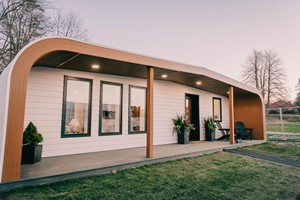This report examines the potential of hemp-based materials as a viable and environmentally responsible alternative within the building construction sector. We will explore the environmental benefits of hemp compared to conventional materials and analyze its impact on greenhouse gas reduction.
Hemp: A Carbon Sequestration Powerhouse
Research by Bernardino D’Amico of Edinburgh Napier University highlights the carbon sequestration properties of hemp. Similar to timber, hemp is a biogenic material that absorbs CO₂ from the atmosphere during its growth cycle. When incorporated into construction materials, this CO₂ is stored for the lifespan of the building, effectively mitigating atmospheric greenhouse gas concentrations.
Hemp Outpaces Timber
While timber is a recognized low-carbon building material, this report emphasizes hemp's superior growth rate. This rapid growth cycle enables hemp to sequester CO₂ at a considerably faster pace per unit of land area.
Hemp-Based Building Products: Diverse Applications
This report details various applications for hemp in construction. Raw hemp fibers can be processed into insulation panels and mats, offering superior thermal and acoustic insulation properties. Additionally, hemp lime, a composite material combining hemp fibers with mortar, presents a viable substitute for concrete blocks in load-bearing walls.
Addressing End-of-Life CO₂ Release
The report acknowledges the eventual release of sequestered CO₂ when hemp-based building materials reach their end-of-life. However, it emphasizes the value of delaying this release, particularly as we develop and implement further mitigation strategies.
Lower Embodied Carbon Footprint
This report highlights the significant advantage of lower embodied carbon associated with hemp-based materials compared to traditional building materials. Embodied carbon refers to the CO₂ emissions associated with material extraction, transportation, and manufacturing processes. Here, hemp offers a clear environmental advantage.
Beyond Carbon Sequestration: Additional Environmental Benefits
Hemp cultivation offers several environmental benefits beyond carbon sequestration. It promotes healthy soil by encouraging beneficial microorganisms and preventing erosion. Furthermore, hemp possesses the ability to remediate contaminated soil through phytoremediation, a process where plants absorb pollutants. Additionally, hemp requires less water irrigation compared to many crops and exhibits natural resistance to pests, potentially reducing reliance on chemical pesticides.
Hemp Renaissance: A Resurgence of Sustainability
The report provides a historical context for hemp cultivation, highlighting its decline due to factors like competition from cotton and the rise of synthetic materials. However, it emphasizes the recent resurgence of hemp production, driven by its environmental benefits and advancements in processing technologies.
Challenges and Opportunities for Growth
The report acknowledges potential challenges associated with large-scale hemp production, such as land availability and initial cost competitiveness. However, it expresses optimism that these challenges can be overcome as production scales up and legislation evolves to support a renewed hemp industry.
Building a Sustainable Future with Hemp
The report presents hemp as a promising and sustainable material for building construction. Hemp offers the potential to significantly reduce greenhouse gas emissions through carbon sequestration and boasts a lower embodied carbon footprint compared to traditional materials. With ongoing research and development, hemp-based construction presents a revolutionary opportunity for the building industry to contribute to a more sustainable future.
by Bernardino D'Amico












